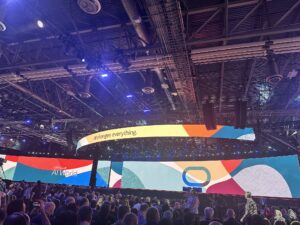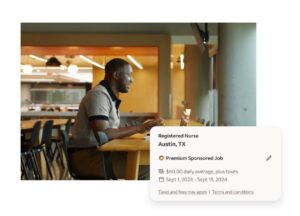Disruption or Displacement? What AI Means for Work and Workers
September 9, 2025
The name Geoffrey Hinton might not be familiar to you, but he and the technology that he helped create and inspire, are likely to have a significant impact on your organization and maybe even your own career in the next few years.
Hinton, widely known as the “Godfather of AI,” is a British-Canadian scientist whose pioneering research laid the foundation for the artificial intelligence systems we use today. Awarded the 2024 Nobel Prize in Physics for his groundbreaking contributions to machine learning, Hinton’s work made it possible for computers to recognize patterns in speech, images, and data in ways that now power everything from workplace software to generative AI tools.
However, in recent years, he has also become one of the most influential voices urging society to carefully consider the implications of AI on jobs, skills, and the future of work—warning that while AI can drive massive productivity gains, it also poses risks of displacement and profound shifts in how people and organizations operate.
In a recent interview with the Financial Times, Hinton said that “What’s actually going to happen is rich people are going to use AI to replace workers. It’s going to create massive unemployment and a huge rise in profits. It will make a few people much richer and most people poorer.”
Additionally, he noted that this disruption isn’t the fault of AI, but rather the “capitalist system”.
Concerns about technology disrupting jobs are not new—they echo through every major wave of innovation in modern history. When the steam engine revolutionized manufacturing and transportation in the 18th and 19th centuries, workers feared widespread unemployment as machines took over tasks once performed by hand. Later, the spread of electricity and mechanization sparked similar anxieties, with some critics warning that automation would leave millions without work. The same pattern repeated itself with the arrival of automobiles, telephones, and later computers—each time, predictions of massive job loss accompanied the adoption of transformative new tools.
Yet history shows that while new technologies often displace certain roles, they also create entirely new industries, professions, and opportunities. The automobile not only reduced demand for blacksmiths and carriage makers but also fueled growth in manufacturing, logistics, road construction, and retail. The spread of the telephone eliminated the role of human telegraph operators, yet it enabled global business, customer service, and entire communication industries. Computers and the internet reduced demand for typists and switchboard operators, but they ushered in the digital economy, IT services, software, and millions of roles that didn’t exist a generation earlier.
What each of these examples underscores is that technology does not simply erase specific jobs or types of work, in fact it changes the nature of work. The economy tends to expand and reorganize as new capabilities emerge, even if the transition is disruptive in the short term. That perspective is especially relevant today as artificial intelligence raises fresh questions about the future of jobs. While fears of displacement are valid, especially in roles directly impacted by automation, history suggests that new industries, skillsets, and opportunities will also arise, often in ways that are difficult to foresee at the outset of a technological revolution.
At the same time, many experts caution that artificial intelligence may represent a departure from the historical script. Unlike past technologies that primarily displaced physical or routine tasks, AI has shown the ability to replicate and even outperform human work in complex, high-income roles such as software development, legal research, and creative content generation. Geoffrey Hinton himself has warned that these systems are advancing so quickly, and are so versatile, that the familiar pattern of short-term displacement followed by long-term job growth may not hold this time.
Another key difference lies in how the benefits of AI are likely to be distributed. While previous technological revolutions created broad-based industries that employed millions, the gains from AI may be far more concentrated. The infrastructure, models, and platforms are largely controlled by a handful of powerful technology companies, while executives and shareholders stand to benefit disproportionately from cost savings and efficiency improvements. If left unchecked, this dynamic could deepen inequality, with the spoils of AI adoption flowing to the few who own and deploy the technology, rather than being widely shared across the workforce. We are already seeing examples of giddy CEOs talking excitedly about the reductions in force they are able to attribute to the adoption of AI technologies.
The lesson from history is that technology reshapes work in ways that are often difficult to predict in the moment. Past revolutions ultimately expanded economic opportunity, but not without turbulence, inequality, and dislocation along the way. AI may follow a similar path, or it may mark a true break from the past. We could see a new way forward in advanced economies where the scale of automation and the concentration of power in a few organizations fundamentally alters the balance between labor and capital.
For HR and business leaders, the challenge is not just to adopt AI for efficiency and growth, but to do so in ways that keep people at the center. That means thinking beyond productivity metrics and cost savings to consider reskilling, new career pathways, and the social contract between employer and employee in the age of intelligent machines. As AI becomes more mainstream, the real test will be whether leaders can harness its benefits while remembering that every “disruption” ultimately lands on human beings—their workers, their communities, and their customers.
The remarks from Geoffrey Hinton regarding the potential societal damage that AI technology perhaps may foster made me recall another legendary scientist’s own expressions of conflicted feelings if not actual regret over another world-changing innovation.
Robert Oppenheimer, famous as the person most responsible for the development of the first atomic weapons, later used at the end of World War II to unprecedented destruction also became fearful of what his invention meant for the world. In 1945, after the atomic weapons were deployed he told President Truman “I am afraid I have blood on my hands”. And he spent the rest of his life wrestling with the consequences of his invention, warning against nuclear escalation, and urging for international cooperation.
We are reminded that AI, like any breakthrough invention really, must be not only be managed by our imaginations, but also by our consciences.
How we can help
Led by Trish Steed and Steve Boese, H3 HR Advisors harnesses over 40 years of experience to delivery HCM insights and guidance to global organizations.
H3 HR Advisory services
By leveraging technology, analytics, and our deep industry knowledge we can help you to reposition your workforce and ensure that you have the right people with the right capabilities in the right roles to positively impact the growth of your business.
HR Happy Hour Podcast Network
Created in 2009, The HR Happy Hour Show is hosted by Steve Boese and Trish Steed and is the longest continuously running internet radio show and podcast on Human Resources, HR Technology, Talent Practices, Workplace and Leadership topics.
H3 HR Speaking Services
We work closely with every client to customize your content - keynotes, webinars, research, infographics, and buyer’s guides - to inspire, educate and inform the audience enabling you to reset and realign your organization for a talent-led breakthrough.
Get in touch
Talk to us today and find out how we can help you and your organization leverage HCM technology to attract, onboard, retain and manage top talent.




